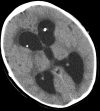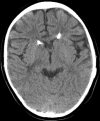Percutaneous placement of the peripheral catheter to the subclavian vein for a VA shunt
- PMID: 28761618
- PMCID: PMC5516673
- DOI: 10.11604/pamj.2017.27.42.11374
Percutaneous placement of the peripheral catheter to the subclavian vein for a VA shunt
Abstract
Hydrocephalus is a common neurosurgical pathology that affects people of all ages and especially the pediatric population. It can be very often a life threatening condition that pediatric neurosurgeons must deal with. Therefore a number of CSF diversion techniques have been established. The gold standard treatment currently is the placement of a ventriculo-peritoneal shunt. Because of hydrocephalus being a lifelong condition, it is almost in daily practice dealing with cases of shunt failures for a number of reasons. Herewith we present a 4 year old child with multiple ventriculo-peritoneal shunt revision surgeries and ventriculo-atrial failure due to distal catheter malfunction that was treated with percutaneous placement of the peripheral catheter in the subclavian vein.
Keywords: Ventriculo-atrial shunt; hydrocephalus; percutaneous; subclavian vein.
Figures
References
-
- Lamesch A J. Ventriculogastrostomy by means of a gastric tube for the treatment of hydrocephalus: A preliminary report. Journal of pediatric surgery. 1972;7(1):55–9. - PubMed
-
- Fountas K N, Kassam M A, Grigorian A A. A rare, delayed complication of a ventriculogallbladder shunt: Case report and review of the literature. Neurosurgical focus. 2007;22(4):1–3. - PubMed
-
- Ketoff J A, Klein R L, Maukkassa K F. Ventricular cholecystic shunts in children. Journal of pediatric surgery. 1997;32(2):181–3. - PubMed
-
- Shahul Hameed A, Yousaf I, Choudhari K. Urinary bladder calculi complicating ventriculo-vesical shunt. British journal of neurosurgery. 2005;19(5):449–50. - PubMed
Publication types
MeSH terms
LinkOut - more resources
Full Text Sources
Other Literature Sources
Medical




